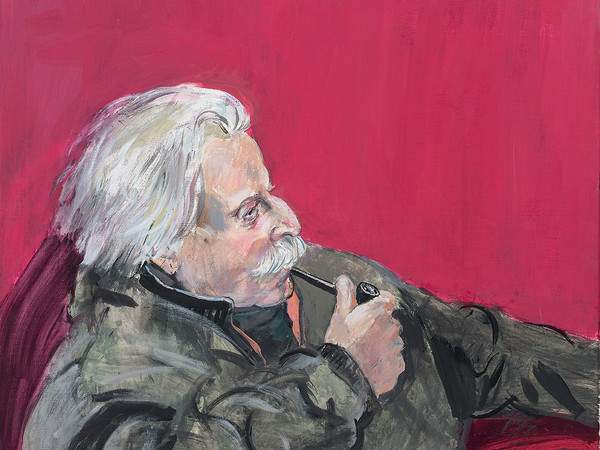An exhibition in Parma dedicated to Renato Vernizzi and Luca Vernizzi, a century of portraits
Held from April 2 to July 31, 2022, at the Monteparma Foundation in Parma, the exhibition IO TU IO. Renato Vernizzi and Luca Vernizzi: A Century of Portraits, with which the foundation continues its activity of rediscovering and enhancing the local artistic heritage by presenting, in a sort of intergenerational dialogue spanning the entire 20th century to the present day, the portraitsof Parma-based painter Renato Vernizzi (Parma, 1904 - Milan, 1972) alongside those of his son Luca Vernizzi (Santa Margherita Ligure, 1941), an accomplished artist who was able to grow in the family groove while always maintaining a strong expressive originality.
Protagonists of this exhibition, curated by Angelo Crespi and Carla Dini, are, along with the two painters, the numerous characters that populate their intense works. In addition to the members of the family, there are, in fact, many well-known faces from the cultural and artistic world, some of whom have strong ties to Parma, making this proposal particularly captivating: Arturo Toscanini, Giorgio Torelli, Baldassarre Molossi, Giulietta Masina, Mariuccia Mandelli (Krizia), Giovanni Testori, Giuseppe Sgarbi, Umberto Veronesi, Paolo Crepet and Mario Andreose are just some of the famous names featured in the exhibition.
The itinerary, consisting of about a hundred works from the art collection of Fondazione Monteparma and from private collectors, allows to reconstruct the salient moments of the artistic production of Renato Vernizzi and Luca Vernizzi, presenting the works of the two painters along autonomous paths but also in an interesting section dedicated to comparisons, discovering the assonances and divergences that characterize their research.
Renato Vernizzi began painting in the temperament of the so-called “return to order” and, in the early years of his apprenticeship, approached the new aesthetics of Novecento, the movement conceived by Margherita Sarfatti, which he exemplifies well in a painting of absolute composure such as Donna che legge (1928). Moving from Parma to Milan in the mid-1930s, Vernizzi turned with interest to the more impressionisticand luminous dictates of Lombard chiarismo. Later on, Renato, in a totally personal path antithetical to the ideological forcings of the time, focused on a painting that looked-with the introspective capacity that has always characterized him-as much to the great sixteenth-century portrait painters as to the later proposals of Manet, Boldini, Casorati and Sironi.
In addition to portraits of well-known personalities, Vernizzi’s rich production of family portraits stands out, in which his pictorial style is sublimated: acts of devotion to the people dearest to him, for which he prefers pure portraits, true loving glances imbued with subtle lyricism. Emblematic expressions of this are the Ritratto di mia moglie (1953), Ritratto di mio padre (1957), Isabella in costume (1954) or the Ritratto di Luca di spalle alla finestra (1956) in which his gaze and the cut of his eyes make him, seventy years later, still immediately recognizable.
Luca Vernizzi from a young age developed his own original stylistic signature, never in opposition to that of his father but neither in slavish continuity with him, traversing all Italian art from the 1960s onward from figurative. Throughout his long career, he painted, like his father, with a style that was often out of fashion: courageously in antithesis to minimalist, poverist and conceptual drifts, he moved toward the progressive rarefaction of all superstructure, toward the elimination of everything that was not essential to the representation, going so far as to propose works in which the subjects - people or things - camp solitary on the blank canvas. This tendency toward “rarefaction” and “subtraction” is precisely found in many of his portraits in which the person depicted stands out from the backdrop which, gradually over the years, became increasingly devoid of other elements, eventually coinciding with the simple prepared canvas. This, in part, is also due to the fact that the painter always works with the live model: his speed of execution, however, does not deny him his great ability to capture the character of people, their essence, their status.
There are several works by Luca Vernizzi that, in addition to the portraits of celebrities already mentioned, will intrigue visitors: Portrait of his maternal grandmother (1976), Portrait of Luciana Savignano (1984), Valentina Cortese (1990), Pietro and Marianna Codispoti (2007), Portrait of Mario Andreose (2019), and finally some of his self-portraits.
For all information, you can visit the official website of APE Parma Museo.
Pictured: Luca Vernizzi, Portrait of Giorgio Torelli (1998).
 |
| An exhibition in Parma dedicated to Renato Vernizzi and Luca Vernizzi, a century of portraits |
Warning: the translation into English of the original Italian article was created using automatic tools. We undertake to review all articles, but we do not guarantee the total absence of inaccuracies in the translation due to the program. You can find the original by clicking on the ITA button. If you find any mistake,please contact us.





























